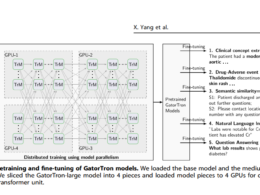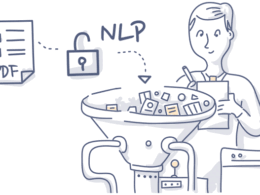Scotiabank — one of the Big Five banks based in Canada — has caught up to competitors in some crucial areas.
It has done so by (1) more closely integrating its data and analytics work; (2) taking a pragmatic approach to AI; and (3) focusing on reusable data sets, which help with both speed and return on investment.
MIT Sloan Management Review
Thomas H. Davenport and Randy Bean
December 29, 2021
Some organizations may feel that acquiring AI capabilities is a race, and if a company starts late, it can never catch up.
That notion is belied by Scotiabank (officially the Bank of Nova Scotia), which has pursued a results-oriented approach to artificial intelligence over the past two years.
While some of its resources are devoted to exploring how new technologies — including blockchain and quantum computing — might drive fresh business models and products, the great majority of its data and AI work is focused on improving operations today rather than incubating for the future.
… the great majority of its data and AI work is focused on improving operations today rather than incubating for the future.
As a result, Scotiabank — one of the Big Five banks based in Canada — has caught up to competitors in some crucial areas. It has done so by
- more closely integrating its data and analytics work;
- taking a pragmatic approach to AI; and
- focusing on reusable data sets, which help with both speed and return on investment.
- First Step: A New Organizational Structure
- A Highly Pragmatic Approach to AI
- ‘RAD-ical’ Changes in Data Provision
First Step: A New Organizational Structure
While some of Scotiabank’s competitors made early moves to build or acquire AI capabilities, Scotiabank, by its own admission, got a slow start in comparison. It was involved in a large-scale digital transformation and had some false starts along the way. By mid-2019, Brian Porter, the bank’s CEO, felt it was important to get analytics right.
A new team structure focused on customer insights, data, and analytics (CID&A) would be central to the task. Porter appointed Phil Thomas as executive vice president of CID&A, with the bank’s chief analytics officer and chief data officer both reporting to him. A dedicated CIO was added to support the function.
By all accounts, this integrated reporting structure is what allowed Scotiabank to move rapidly to gather and manage the necessary data and put analytics and AI capabilities in place. As one executive told us, “Our incentives, leadership, and personalities are all aligned — there is no friction or blocking.”
For instance, while most of the data scientists are embedded within different parts of the business, the analytics and AI function is centralized. As a result, business leaders drive the agenda for which analytics and AI use cases are developed within their businesses, working through a unit that is the core of the business. “Digitization has made the entire bank visible in data and analytics, and AI people are now a part of the new front lines,” said Grace Lee, who was chief analytics officer until October 2021. (Lee took over leadership of CID&A in October, with Thomas moving up to chief risk officer, a role that includes oversight of CID&A.)

A Highly Pragmatic Approach to AI
Back in 2019, Porter and Thomas decided that the primary focus of the bank’s analytics and AI activity should be customers — hence the “customer insights, data, and analytics” label. Thomas, Lee, and their colleagues felt that improving processes and making better decisions within the bank was the best way to catch up to and surpass competitors.
Thomas felt that, given the bank’s relatively late start, a results-oriented approach to AI was necessary. That’s why there are no “big bang” projects, and there is little pure experimentation or research. Instead, the bank’s key use cases focus on continuous improvement of its operations and customer relationships. Lee told us that as a result, most AI projects are deployed into production, with about 80% of Scotiabank’s analytics and AI models already in place and the other 20% pending.
While many banks focus on their wealthiest customers, Scotiabank decided that during the COVID-19 pandemic, it would try to find the customers (first individual consumers, and later small businesses) most in need of its help. The analytics application uses a machine learning model — called the Customer Vulnerability Index — to identify consumers who are likely to have short-term cash-flow issues, using transactional data such as deposits and spending levels. Those who are found to be most vulnerable are proactively approached by relationship managers, who can discuss options such as mortgage payment deferrals or short-term lending.
Also on the customer front, Scotiabank recently introduced an AI-driven marketing and engagement tool that analyzes both customer life events that the bank knows about (such as a new mortgage, new child, or a child in college) and customer preferences for particular channels (whether it’s branches, mobile, online, the call center, or email) to offer banking advice that’s both personalized and in the channel the customer prefers.
Although the bank’s primary AI focus is on customers, it has use cases in other areas as well. It has found substantial returns from automating tasks in the back office of its global banking marketing division and improving security on the front line. It has also improved call center responses by reducing information search time — by more than a minute per call.
‘RAD-ical’ Changes in Data Provision
The data management function at Scotiabank, headed by Peter Serenita as chief data officer, also made changes. The goal was to more rapidly provide data for analytics and AI use cases — and without the data, the models wouldn’t be possible. Before the 2019 CID&A restructuring, the bank’s data strategy had been primarily focused on defense — a “protect the bank” approach that emphasized regulatory compliance, financial reporting, and risk management.
With the added focus on customer insights and rapid value realization, the data function developed a new approach to data delivery that it called RAD, short for reusable authoritative data set. It identified reusable data sets for customer data, transactional data, balance data, and so forth. Each RAD was classified as requiring a different level of controls based on the use cases it supported. Tier 1, the highest level of controls, was for use cases involving regulatory external reporting; Tier 2 involved models for customers; and Tier 3 was for internal models.
There was a strong focus on reuse of data sets, Serenita told us, so he expected that all RADs would eventually be in Tier 1. But the tiered approach meant that data sets that didn’t initially need the highest level of controls could be provisioned faster. Serenita said he had always found it challenging to produce high ROIs on data projects, but now they are common at Scotiabank.
Scotiabank’s experience provides evidence that organizations getting a late start on AI can catch up to and perhaps surpass competitors that started earlier with the technology. The company’s AI strategy ensures that AI initiatives provide value to the business and that the great majority of them are deployed into production. This strategy also emphasizes improving existing operations and facilitating closer relationships with customers. The clarity of Scotiabank’s objectives, of course, makes them much more likely to be achieved.
About the Authors
Thomas H. Davenport (@tdav) is the President’s Distinguished Professor of Information Technology and Management at Babson College, a visiting professor at Oxford’s Saïd Business School, and a fellow of the MIT Initiative on the Digital Economy.
Randy Bean (@randybeannvp) is founder and CEO of NewVantage Partners, a strategic advisory company that is now a division of Wavestone, a global consultancy based in Paris.
He is the author of Fail Fast, Learn Faster: Lessons in Data-Driven Leadership in an Age of Disruption, Big Data, and AI (Wiley, 2021).
Originally published at https://sloanreview.mit.edu on December 29, 2021.












